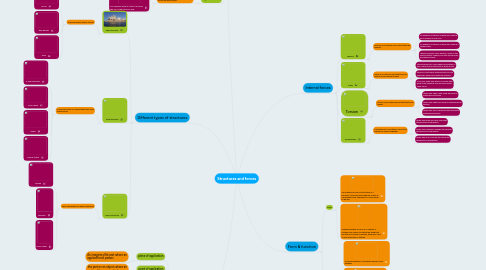
1. Loads
1.1. Dead load
1.1.1. A dead load is the weight of the structure itself.
1.1.1.1. For example: if there is a car that is carrying people the car would be the dead load.
1.2. Live load
1.2.1. A live load is a weight that the dead load has to support.
1.2.1.1. For example: when a shoe hits the ground the shoe is the live load.
1.3. Dynamic load
1.3.1. A dynamic load is a force applied to the structure with motion.
1.3.1.1. For example: when it rains on a house the rain is the dynamic load.
2. External Forces
2.1. plane of application
2.1.1. An imaginary flat part where an applied force passes
2.2. point of application
2.2.1. the part on an object where an external force is applied
2.3. Magnitude
2.3.1. The strength of the force being applied
2.4. Direction
2.4.1. The course that the force is on.
3. Different types of structures
3.1. Shell structure
3.1.1. A hollow object that is curved
3.1.1.1. Dome
3.1.1.2. Bike helmet
3.1.1.3. Igloo
3.2. Solid structure
3.2.1. A solid structure is a object that uses solid construction
3.2.1.1. A concrete dam
3.2.1.2. Sand castle
3.2.1.3. Apple
3.2.1.4. Marble statue
3.3. Frame structure
3.3.1. Parts connected to make a structure
3.3.1.1. Bridge
3.3.1.2. Skeleton
3.3.1.3. Eiffel Tower
4. Internal forces
4.1. Tension
4.1.1. Tension is an internal force that stretches objects.
4.1.1.1. An example of tension is when you stretch your googles to put it on.
4.1.1.2. An example of tension is when you stretch a rubber band.
4.1.1.3. Tension impacts many objects, some of the objects that it impacts includes trampolines and guitar strings.
4.2. Shear
4.2.1. Shear is an internal force that pulls an object in two different ways.
4.2.1.1. Strong winds can cause shear force within a tree. These forces can bend or break a tree.
4.2.1.2. When you cut paper with scissors you are exerting a shear force with the scissors.
4.2.1.3. If you pull apart two pieces of candy that were stuck together you would be using shear force.
4.3. Torsion
4.3.1. Torsion is an internal force that twists and object.
4.3.1.1. When you twist a wet cloth the cloth is experiencing torsion.
4.3.1.2. When you twist your body it is experiencing torsion.
4.3.1.3. When you turn a doorknob the doorknob experiences torsion.
4.4. Compression
4.4.1. Compression is an internal force that presses an object together.
4.4.1.1. When you jump and land, your feet experiences compression.
4.4.1.2. When you squeeze a sponge the sponge experiences compression.
4.4.1.3. When you lie on a pillow the pillow will experience compression.
5. Form & function
5.1. Form
5.1.1. An example of form in structures is a pyramid. A pyramid was originally made as a pharaohs tomb, therefore it's form needs to be big.
5.1.2. Another example of form is in statues. A statues form needs to match the thing that the statue is trying to portray, therefore form is very important in statues
5.2. Function
5.2.1. A houses function is to shelter humans from weather.
5.2.2. The coliseum's function was to provide a place for gladiators to fight.
5.2.3. The great walls function was to keep out invaders and make it harder for them to cross the boundary.

